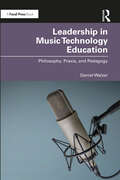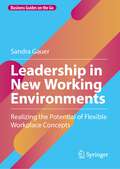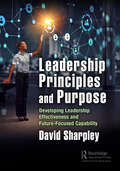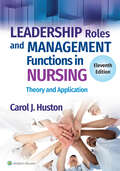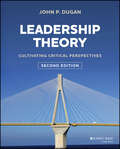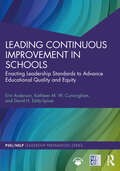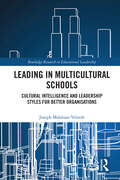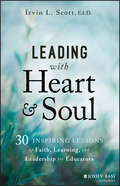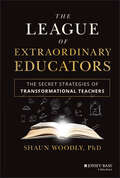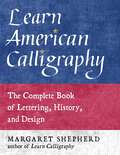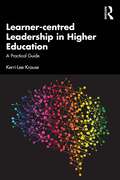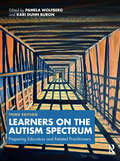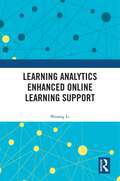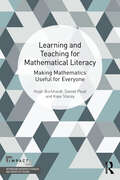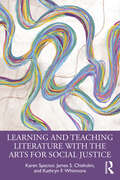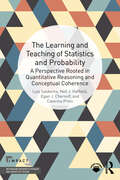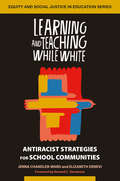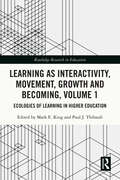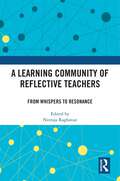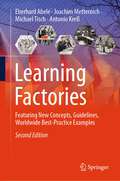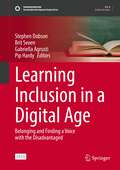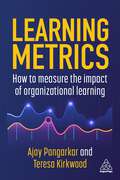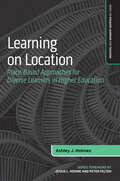- Table View
- List View
Leadership in Music Technology Education: Philosophy, Praxis, and Pedagogy
by Daniel WalzerLeadership in Music Technology Education examines the pedagogical, sociocultural, and philosophical issues that affect curriculum, research, and decision-making in music technology in higher education. This book considers a range of cutting-edge topics, including the impact of the COVID-19 pandemic, professional development concepts, partnerships between higher education and the creative and cultural industries, and the effects technology has on sustainability. Drawing on Leadership theories, including Transformational, Situational, Servant, and Social Change Model Theory, the book puts forward a new model, Creative Industry Leadership, which considers the sociocultural aspects of Music Technology Education, and interrogates biased ideologies that limit opportunities for a broad range of learners and practitioners in education and beyond. Additionally, Leadership in Music Technology Education examines educators’ informal leadership capacities during the COVID-19 pandemic and how inclusive pedagogy expands the creative boundaries of teaching, learning, and music-making for all. Leadership in Music Technology Education is crucial reading for instructors teaching audio engineering and music technology, as well as researchers in education, music pedagogy and related fields. This is also a valuable read for anyone with an interest in music technology and its many potentialities.
Leadership in New Working Environments: Realizing the Potential of Flexible Workplace Concepts (Business Guides on the Go)
by Sandra GauerThis book discusses the challenges that modern and flexible workplace concepts pose for managers. In particular, it addresses the uncertainties and stress factors that employees face when working in multi-space environments and how they become attached to their workplace. Drawing on a hybrid methodological approach that combines a literature review with practical lessons learned as a workplace change consultant, it offers managers concrete advice on how to lead in multi-space environments. This book aims to reduce the uncertainties and stressors caused by new work environments, and ideally to transform them into growth opportunities for the entire company. Providing concrete solutions, it represents a valuable asset for managers, HR professionals, and workplace initiative leaders alike.
Leadership Principles and Purpose: Developing Leadership Effectiveness and Future-Focused Capability
by David SharpleyThis book provides a fresh perspective on leadership and the steps required to achieve high performance. It explores how we create purpose by moving from vision and values through principles to action.Effective leaders do not only support and develop people --They develop systems (anchored in principles and procedures) that support future-focused capability. We all benefit from understanding the elements that contribute to exceptional leadership. Increasingly, we also need to appreciate the building blocks that link to sound corporate governance. Hence, the focus is on Environmental and Social Governance (ESG).The book explains how principles shape competencies and build motivation and commitment. The insights also reveal the importance of confirmed competence. This enhances self-belief and increases personal confidence when faced with challenging situations. It adds to resilience. Building on principles helps clarify how energy is best directed to achieve high performance. This also ensures consistency of approach. Values need to be made explicit through principles, which support the design of systems and help shape the culture of the workplace. Principles have relevance for managers, team leaders, and professionals who want to gain insight into how we enhance motivation and commitment at work. However, the information contained in this book goes further as it also raises self-awareness and encourages reflection on the broader issue of how people find meaning and purpose.
Leadership Roles and Management Functions in Nursing: Theory and Application
by Carol J. HustonCombining an equal focus on leadership and management with a proven experiential approach, Leadership Roles and Management Functions in Nursing: Theory and Application, 11th Edition, delivers the knowledge, understanding, and realistic leadership experience today’s students need to confidently transition to nursing practice. This best-selling text clarifies theoretical content with a wealth of application-based learning exercises that put students into nursing leadership roles and challenge them to think critically, solve problems, and make sound clinical decisions before embarking on their nursing careers. The updated 11th Edition reflects the latest evidence-based content and incorporates engaging online resources that help students establish a foundation for successful nursing practice in any role or clinical setting.
Leadership Theory: Cultivating Critical Perspectives
by John P. DuganA comprehensive volume on leadership theories and their applications—with an emphasis on social justice Leadership Theory: Cultivating Critical Perspectives is an interdisciplinary survey text designed for use in undergraduate or graduate classrooms. This trusted book provides an overview of essential theories in leadership studies, infusing critical commentary to enhance readers’ understanding and practice of leadership. The book uses compelling examples, reflective questions, and illustrations to cultivate your ability to engage as a critical learner. Powerful narratives from accomplished leaders around the world offer insights on the challenges and rewards of leadership. This revised edition incorporates the latest research in the field of leadership, as well as substantial changes aimed at bringing increased cohesion to the text. New narratives lend a fresh and relevant tone that today’s learners will appreciate. · Learn the fundamental concepts, origins, and evolution of 20+ leadership theories · Understand the pros and cons of different leadership theories, so you can apply them wisely and effectively · Consider the influences of ethics, justice, and social location on leadership · Focus on leadership practices that promote social justice and equality Students studying leadership, as well as professionals developing their leadership skills within specific disciplines, will gain a thorough appreciation of the real-world complexities of leadership and how the leading theories attempt to capture them.
Leading Continuous Improvement in Schools: Enacting Leadership Standards to Advance Educational Quality and Equity (PSEL/NELP Leadership Preparation)
by Erin Anderson Kathleen M. Cunningham David H. Eddy-SpicerThis volume provides a set of principles and systematic methods for improvement to help district and school leaders achieve the continuous improvement goals embedded in the Professional Standard for Educational Leadership (PSEL) and the National Educational Leadership Program (NELP) standards. Bringing the PSEL Standard 10 to life, this book tackles the why, how, and what of continuous improvement through an equity lens. In the first section, Leading Continuous Improvement in Schools provides an overall introduction to and rationale for continuous improvement, situating current approaches to continuous improvement, situating current approaches to continuous improvement in education within broader historical and sectoral contexts. The second section highlights how the tenets of improvement science – such as making iterative, incremental, evidence-based advancements; utilizing practical measurements; and acknowledging variability – position school and system leaders to adaptively integrate systematic and evidence-based approaches to change as part of ongoing organizational processes. The book concludes with a section that invites readers to consider leadership approaches that forward improvement work, how leaders can build internal capacity to engage in improvement, and how policy can support efforts to build and sustain the capacity for continuous improvement. Special features include beginning-of-chapter highlights, end-of-chapter connections to standards, and action inventories through each chapter. Overall, the volume provides a focus on the continuous improvement aspects of the NELP and PSEL standards that serves as a bridge, supporting students preparing to become educational leaders in their journey from learning about continuous improvement to learning how to lead continuous, equity-oriented improvement work in their own contexts.
Leading Continuous Improvement in Schools: Enacting Leadership Standards to Advance Educational Quality and Equity (PSEL/NELP Leadership Preparation)
by Erin Anderson Kathleen M. Cunningham David H. Eddy-Spicer• Aligns improvement efforts with two sets of standards, NELP and PSEL – no other books in the field do this. • To help ground the main points in this volume, each chapter features a case that presents a leader who is simultaneously leading a school while also learning about improvement science in their graduate class. • To help instructors use this book in their courses, each chapter includes teaching notes and an action inventory aligned to the case examples and chapters. • Uses Improvement Science as a method of continuous change and equity as a values framework—this book centers equity in every improvement effort • This book helps to reframe the conversation about how data can be used by leaders for improvement -- it emphasizes creating a data culture that allows for experimentation and learning from failure and does not limit emphasis on lagging accountability data. • This book is comprehensive with attention to foundational theory and research on continuous improvement, practical methods of continuous improvement, and the leadership of continuous improvement
Leading in Multicultural Schools: Cultural Intelligence and Leadership Styles for Better Organisations (Routledge Research in Educational Leadership)
by Joseph Malaluan VelardeVelarde explores how cultural competencies and leadership styles can be integrated and maximised to create and sustain a healthy environment for better learning. The integration of cultural intelligence and effective school leadership practices shapes the foundation for a culturally strategic leadership. This book uses research from Malaysia supported by cases and studies from various parts of the world to bring readers perspectives that can be applied in an international context. Velarde examines how various school leaders (i.e., principals, coordinators, heads of department, teacher leaders) in national and international schools utilise cross-cultural capabilities and leadership styles in their multicultural schools to work inclusively on a shared vision despite the challenges of cultural conflicts. As a framework in leading in multicultural schools, its culturally strategic leadership principles and practices come from the examination of current research in cultural intelligence and educational leadership to provide scholars and practitioners an alternative perspective and practical guide in school leadership and its intended outcomes. This insightful, practical, and reflective guide will be useful as a reference for scholars and students in the field of educational leadership and management. As a supplement to teaching modules in universities, lecturers of school leadership will also find this book resourceful.
Leading with Heart and Soul: 30 Inspiring Lessons of Faith, Learning, and Leadership for Educators
by Irvin L. ScottA spiritually grounded source of inspiration and answers for education leaders in troubling times Public confidence in schools is waning, and there remains an unprecedented teacher shortage in the United States. Leading with Heart and Soul: 30 Inspiring Lessons of Faith, Learning, and Leadership for Educators shows leaders how to use spiritual principles to care for teachers, students, and other stakeholders despite these obstacles. Principals, superintendents, and others will gain motivation from the stories and strategies inside. Drawing on spiritual principles and Dr. Irvin Scott's experience as a classroom, school, district, and non-profit leader, this book will reinvigorate you and your team as you try to answer your most pressing questions about the future of education, including: How do we empower innovative, servant-hearted educational leaders to meet the needs of students? How do we inspire whole communities to support the learning journeys of their youth? How do we engage the entire educational ecosystem—including nonprofits and other organizations—to uplift equitable opportunities to learning and ensure that every student has the resources needed to thrive? This is not a time for leaders to turn away from our children, their caregivers, and the educators who teach and nurture them. Instead, it is a time to lift them up and celebrate the work they do while navigating our own administrative mandates and challenges. Leading with Heart and Soul speaks directly to the individuals in a position to achieve that goal. It is perfect for book clubs; personal study; and within public, Christian private, and faith-based charter schools.
The League of Extraordinary Educators: The Secret Strategies of Transformational Teachers
by Shaun WoodlyDeliver on the promise of equity and transformational instruction in your classroomIn The League of Extraordinary Educators, veteran educator Dr. Shaun Woodly delivers a rousing narrative designed to take readers on a journey of empowerment, motivation, rich learning experiences, classroom synergy and even secrecy! You’ll learn how to transform teaching and learning through empowering connections at all levels in the classroom, saying goodbye to outdated, ineffective teaching practices and saying hello to instructional methods that authentically captivate students from diverse backgrounds.In the book, you’ll also find: Transformative practices that emerge from a combination of inspiration, mindset shifts, as well as practical techniques and strategies A focus on the importance of human connection, culturally significant learning experiences and community in the classroom A revolutionary story the reveals the secret strategies of transformational educations in urban and culturally diverse schools An indispensable resource for K-12 teachers, instructional staff, as well as leaders and administrators facing tough issues around creating meaningful learning experiences for students from underserved and underrepresented backgrounds, The League of Extraordinary Educators will set the stage for learning environments that authentically engage to create equitable academic outcomes for all students. All meaning all!
Learn American Calligraphy: The Complete Book of Lettering, History, and Design
by Margaret ShepherdTake a visual trip around the United States, with stop-offs in many locations and insights on every page, and illuminate the past and future of American calligraphy. For centuries, American calligraphers have accepted the legacy of the classic Roman, Gothic, and Italic calligraphy they inherited from Europe without realizing that there are more alphabet treasures to be found in a larger pool of uniquely American alphabet designs. Wild West, New Deal, Prairie—all were made in America, and they express ideas that reveal national character. These styles come from here and nowhere else. Much like American music, language, fashion, and philosophy, calligraphy has matured, moved on from its origins, and become, in the words of the man who created Spencerian handwriting, &“even more American.&” Learn American Calligraphy is the latest book from Margaret Shepherd, author of one of the all-time bestselling books on calligraphy, Learn Calligraphy. This new book focuses on American calligraphy, which has its own identity, distinct from the alphabets inherited from Europe. As a lifelong calligrapher, Shepherd surveys the landscape of unique styles and describes how two dozen alphabets originated and what shaped them. Simple diagrams and exercises help you try out the styles for yourself. Some letters represent a region or a major era of art; some bear witness to social upheaval or culture change; many are accessible to beginners; and a few contradict the established view of American history.
Learner-centred Leadership in Higher Education: A Practical Guide
by Kerri-Lee KrauseThis is the go-to guide for higher education leaders of learning, teaching and the learner experience. It offers research-enriched, practical insights and case studies, together with a must-have toolkit of strategies for future-focused higher education leaders. Kerri-Lee Krause combines her extensive track record as a senior university executive, award-winning teacher and higher education researcher. Inspired by the disruptive educational opportunities arising from the global COVID-19 pandemic, Krause takes academic and professional staff leaders on a journey through the core capabilities required of successful leaders in a rapidly changing higher education landscape. Key topics include: learner-centred strategy co-design; collaborative strategy implementation with learners at the heart; leading curriculum innovation and renewal; partnering with learners for engagement and success; collegial academic and professional staff capability-building and leadership development; coming to terms with educational policy development and quality work; shaping learner-centred cultures; and leading with integrity in higher education. As universities and higher education providers look for ways to rebuild in the wake of a global pandemic, capable, courageous, learner-centred leadership matters more than ever. This readable, intellectually rich and practical book is for current and aspiring higher education leaders who have a passion for effective leadership with learners at the heart.
Learners on the Autism Spectrum: Preparing Educators and Related Practitioners
by Pamela Wolfberg Kari Dunn BuronThis third edition is a foundational text that has been updated and expanded to prepare educators, therapists, and other care providers with vital knowledge and practical skills to support diverse learners on the autism spectrum. Covering an expanse of fundamental topics, this edited volume features new directions in research and practice that are essential to understanding the ever-changing field of autism. Along with new chapters from leading experts (including those who identify as autistic), this revision places greater emphasis on the intersection of neurodevelopmental differences with ethnicity, race, culture, language, gender expression, and socioeconomic experiences. The diverse disciplines and perspectives presented provide a foundation on how these students learn and how best to provide them with effective teaching, therapy, and social supports. This book equips readers with knowledge and skill to competently apply reflective and humanistic practices that prioritize the preferences, strengths, and values of autistic learners from all walks of life.
Learning Analytics Enhanced Online Learning Support
by Shuang LiOffering the latest developments in online education in the era of big data, this book explores theories, technologies, and practices in the field of data-driven online learning support services using learning analytics. This book is divided into five chapters. Chapter 1 reflects and reconstructs the connotation of learning support against the backdrop of education reform, the rise of learning analytics, and the upgrading of the demand for learning services in the new era. Chapter 2 presents a P-K-DSE-E model of online learner characteristics and discusses measurement and data representation methods for learner characteristics based on it. Chapters 3–5 focus on the three types of learning support that are closely related to learning performance and satisfaction, including the promotion of social learning, electronic learning assessment based on the learning process, and personalized tutoring and support. This book innovatively develops the concept, theory, and practical methods of student support services in distance education traditional practices in the new era and provides valuable exploration of data-driven personalized learning service methods and technologies in the era of artificial intelligence through rich examples. This book will be essential reading for students and scholars of distance and online education, educational technology, and audiovisual education.
Learning and Teaching for Mathematical Literacy: Making Mathematics Useful for Everyone (IMPACT: Interweaving Mathematics Pedagogy and Content for Teaching)
by Hugh Burkhardt Daniel Pead Kaye StaceyTypically, most people don’t realize when and how they can use the mathematics they were taught in high school – yet many of the mathematical ideas and skills can be a powerful tool for understanding how the world works. Learning and Teaching for Mathematical Literacy addresses this situation, offering practical strategies for developing a broader vision of mathematical literacy in the classroom and recognising the importance of maintaining these skills into adult life. Linked to the material explored throughout this book, classroom activities and lesson materials are freely available for use via the QR codes included in each chapter. Filled with case studies and classroom activities, chapters tackle several topics: Describing a framework for a broader vision of mathematical literacy – what is it, and why is it important? Teaching mathematical literacy in the classroom Applying mathematical literacy to ‘real life’ scenarios: My dad is buying a new dishwasher. Should he buy the extended warranty on offer? My phone works fine but I've been offered an upgrade. How should I decide whether to take it? The role of technology in teaching mathematical literacy Designing mathematical measures for real-word quantities Firmly grounded by practical applications for the classroom and beyond, this is an essential handbook for any teacher, teaching assistant, or mathematics subject lead who wishes to develop their students’ mathematical literacy skills. This is also an ideal resource for those delivering or enrolled in teacher preparation courses.
Learning and Teaching for Mathematical Literacy: Making Mathematics Useful for Everyone (IMPACT: Interweaving Mathematics Pedagogy and Content for Teaching)
by Hugh Burkhardt Daniel Pead Kaye StaceyTypically, most people don’t realize when and how they can use the mathematics they were taught in high school – yet many of the mathematical ideas and skills can be a powerful tool for understanding how the world works. Learning and Teaching for Mathematical Literacy addresses this situation, offering practical strategies for developing a broader vision of mathematical literacy in the classroom and recognising the importance of maintaining these skills into adult life. Linked to the material explored throughout this book, classroom activities and lesson materials are freely available for use via the QR codes included in each chapter.Filled with case studies and classroom activities, chapters tackle several topics: Describing a framework for a broader vision of mathematical literacy – what is it, and why is it important? Teaching mathematical literacy in the classroom Applying mathematical literacy to ‘real life’ scenarios: My dad is buying a new dishwasher. Should he buy the extended warranty on offer? My phone works fine but I've been offered an upgrade. How should I decide whether to take it? The role of technology in teaching mathematical literacy Designing mathematical measures for real-word quantities Firmly grounded by practical applications for the classroom and beyond, this is an essential handbook for any teacher, teaching assistant, or mathematics subject lead who wishes to develop their students’ mathematical literacy skills. This is also an ideal resource for those delivering or enrolled in teacher preparation courses.
Learning and Teaching Literature with the Arts for Social Justice
by Karen Spector James S. Chisholm Kathryn F. WhitmoreThis text invites pre-service teachers to explore arts-informed practices that showcase the transformative potential of literature in the classroom. Through the lens of "stories-we-live-by," the authors recognize literature as interference, capable of disrupting the habitual patterns through which we interpret the world in order to reawaken the capacity of students and teachers alike to change. Chapters are designed to inspire students’ love of literature by fostering literary and artful encounters that provoke their thinking and sense-making. Each chapter includes engaging pedagogical features that spark thinking and analysis of literature and invite readers to further engagement. The appendices include directions for instruction as well as additional resources. An essential text for courses on children’s and adolescent literature and English methods, pre-service teachers will come away with plenty of text recommendations and arts- and social justice-informed practices to use with their future students. Through artful encounters with visual learning analyses, visual-verbal journals, drama, soundscapes, poetry, and so much more, readers examine their own transformative experiences with literature. Readers will learn to craft and curate practices that encourage engagement, imagination, experimentation, and self-awareness in and beyond the classroom.
The Learning and Teaching of Statistics and Probability: A Perspective Rooted in Quantitative Reasoning and Conceptual Coherence (IMPACT: Interweaving Mathematics Pedagogy and Content for Teaching)
by Luis Saldanha Neil J. Hatfield Egan J Chernoff Caterina PrimiFilled with practical learning activities to adopt within your classroom, The Learning and Teaching of Statistics and Probability places reasoning about quantities and quantification at the core of learning and teaching statistics. A companion website to this book is also available at https://neilhatfield.github.io/IMPACT_Statistics/, allowing readers to access a directory of resources – data collections and web-based applets – used in some of the instructional activities featured within this book. Through its presentation of conceptual analyses and resources for teaching with statistical data, the book’s five chapters establish key concepts and foundational ideas in statistics and probability, emphasizing the development of learner understanding and coherence, for example: Individual cases and their attributes Data collections, sub-collections, and relevant operations to quantify their attributes Samples, population, and quantifying variation Types of processes, meanings of randomness, and probability as a measure of stochastic tendency Sampling distributions and statistical inference. This highly informative yet practical book is an indispensable resource for teachers of secondary school mathematics, mathematics subject leads, and mathematics and statistics educators within the wider field of education.
Learning and Teaching While White: Antiracist Strategies for School Communities (Equity and Social Justice in Education Series)
by Jenna Chandler-Ward Elizabeth DeneviWe need to name whiteness, in order to move toward antiracism. For too long, white educators have relied on people of color to make change to a relentlessly racist school system. Racial equity will not come until white educators recognize their role in supporting racist policies and practices, and take responsibility for dismantling them. Learning and Teaching While White is an accessible guide to help white educators, leaders, students, and parents develop an explicit, skills-based antiracist practice. Through their own experiences working with school communities, and the strategies and tools they have developed, Jenna Chandler-Ward and Elizabeth Denevi share how white educators can gain greater consciousness of their own white racial identity; analyze the role of whiteness in their school systems; rethink pedagogical approaches and curricular topics; address the role of white parents in the pursuit of racial literacy and equity; and much more. Their book will empower white educators to be part of creating a more equitable educational system for all students.
Learning as Interactivity, Movement, Growth and Becoming, Volume 1: Ecologies of Learning in Higher Education (Routledge Research in Education)
by Paul J. ThibaultThe two inter-linked volumes in this series are dedicated to the development of analysis and theorisation of learning and teaching in higher education. The two volumes focus on the multi-scalar ecological inter-connectedness of learners with teachers, with artefacts, with cultural patterns and resources, with places, with social activities and practices, with social institutions, with time and temporality, and with technologies. Learning reflects inter-individual dynamics that are shaped by biology and culture. Against prevailing orthodoxies that view learning in higher education in terms of "information transmission" and "content delivery," the contributors articulate leading developments in distributed cognition, distributed language, ecological psychology, enactivist and embodied-embedded cognitive science, interactivity, and multimodal event analysis. They also extend several earlier traditions such as American pragmatism, embodied curriculum theory, and Vygotsky's latter day anti-dualist Spinozan turn. Through detailed empirical analysis of in vivo episodes of learning using multimodal event analysis, cognitive event analysis, and cutting-edge theory, the authors show how and why learning is not adequately explainable as internal mental processes per se. Instead, sophisticated empirical analysis and innovative theory are put to work to reveal the emergence of learning in the interactivity of learners and teachers with the affordances of a distributed brain-body-environment learning system. Volume 1 is an edited collection of seven chapters written by internationally renowned researchers together with an Introduction and an Afterword written by King and Thibault. Volume 1 (and its successor Volume 2) will serve as valuable reading for educationalists and researchers in the cognitive, communication, learning, and language sciences who are looking for new multidimensional tools for thinking about, and new empirical tools for analysing, learning, and teaching as multi-scalar interactive processes in radical embodied ecologies of learning and teaching.
A Learning Community of Reflective Teachers: From Whispers to Resonance
by Neeraja RaghavanTeachers possess a wealth of untapped wisdom and valuable experience. Whether it’s in matter of educational policy, curriculum development or textbook selection, teachers carry a trove of information and insights to share. Traditionally, teacher development has been driven by administrators of schools, and it often takes the form of a ‘mentor’ teaching the staff of a school. But what happens when teachers across different locations collaborate and learn together? This volume documents such an initiative, sparked off by the Covid-19 pandemic, which brought people together online. It underscores the power of teachers debating, discussing, and learning from each other. Based on an Indian experience, the book addresses a range of issues teachers and educators face across the world — encompassing pedagogy, classroom management, school culture and teacher development. A unique story of community building and teacher education, this book also contains key outcomes and insights which take us through their action research projects and showcases a model of teacher development that can be adopted by interested readers. Above all, it brings out the crying need for a teacher’s voice to be heard — for far too long, teachers have been mere implementers of decisions taken by policy makers or managements of schools. By means of networking communities such as the one described in this book, the transformation of teachers going from whispers to resonance is greatly amplified. An important intervention in the domain of teacher development, this volume will be of great interest to students, researchers and practitioners of education, teacher education, and sociology of education. It will also be useful for teacher trainees, academicians, teacher educators, policymakers, schoolteachers, curriculum developers, teacher training institutes, and universities offering teacher education programs.
Learning Factories: Featuring New Concepts, Guidelines, Worldwide Best-Practice Examples
by Eberhard Abele Joachim Metternich Michael Tisch Antonio KreßThis book presents the state of the art of learning factories. It outlines the motivations, historic background, and the didactic foundations of learning factories. Definitions of the term learning factory and an updated morphological model are provided as well as a detailed overview of existing learning factory approaches in industry and academia, showing the broad range of different applications and varying contents in all continents. International learning factory best-practice examples are presented in detailed and structured manner. The state of the art of learning factories curricula design and their use to enhance learning and research as well as potentials and limitations are presented. Further research priorities and innovative learning factory concepts to overcome current barriers are offered. While today numerous learning factories have been built in industry (big automotive companies, pharma companies, etc.) and academia in the last decades, a comprehensive handbook for the scientific community and practitioners alike is still missing. The book addresses therefore both researchers in production-related areas that want to conduct industry-relevant research and education, as well as managers and engineers in industry, who are searching for an effective way to train their employees. In addition to this, the learning factory concept is also regarded as an innovative learning concept in the field of didactics.
Learning Inclusion in a Digital Age: Belonging and Finding a Voice with the Disadvantaged (Sustainable Development Goals Series)
by Stephen Dobson Brit Svoen Gabriella Agrusti Pip HardyThis open access book considers how inclusive learning, wellbeing and active citizenship can be encouraged, taught, learnt, and supported in a digital world. The book poses and seeks to address three questions: How can governments and intergovernmental organisations support learning inclusion and active citizenship? How can the education sector and public/private enterprises support learning inclusion and active citizenship? How can professionals and communities work with vulnerable adults who are disadvantaged in a participatory, empowering manner? The Examples discussed in the book draw on the experiences of adult refugees and migrants, as well as people who may experience disadvantage and/or discrimination as a result of their social, economic, political, cultural, religious, physical, mental, age or gender-related status. One methodological pillar in this work is the development of skills in digital storytelling and digital stories creation for personal, community and professional purposes. Conceptually and of interest for researcher and policy makers at local, national and transnational levels, this book brings together a number of related concepts to generate innovative understanding and practices of applied relevance in the age of the pandemic and its aftermath.
Learning Metrics: How to Measure the Impact of Organizational Learning
by Ajay Pangarkar Teresa KirkwoodHow do I know if Learning and Development (L&D) initiatives are making a difference to employee and business performance? What should I measure and how do I take a data-driven approach?Learning Metrics is a practical book for L&D professionals which answers these questions and provides guidance for measuring and communicating the impact of L&D activity in the business. It covers how to measure participant engagement with learning, learning retention and changes in employee performance post-learning. There is also guidance on how to measure on-the-job behaviour change as a result of learning, as well as metrics for measuring the organizational impact of learning. This book also has essential guidance on how to use learning analytics to assess the return on investment (ROI) of learning and how to use these results to adopt a data-driven approach and map learning metrics to organizational KPIs. Learning Metrics also includes guidance on how to communicate the impact of the company's learning and development activity to all business stakeholders. Full of practical guidance, examples, advice and case studies from organizations including Pfizer, Goldman Sachs, HSBC, Merck and Hewlett Packard, this is essential reading for all L&D professionals needing to measure the impact of L&D activity in the business but not sure where to start.
Learning on Location: Place-Based Approaches for Diverse Learners in Higher Education (Series on Engaged Learning and Teaching)
by Ashley J. HolmesThis book offers an innovative framework and set of pedagogical pathways for deepening college student learning through critical engagement with place. Though the what and how of teaching and learning rightly take center stage in research of best practices, this book argues that the where of education deserves increased attention. Drawing from interviews and case studies with college and university educators in the United States and Canada, Learning on Location highlights pedagogies-in-action and identifies programmatic models for embedding location-based learning within specific courses, majors, curricula, and campus-wide initiatives. Chapters provide a mix of theoretical framing and practical application, with three key practices grounding the text: writing on location, walking on location, and engaging the civic on location. This resource is an invaluable guide for higher education faculty, leaders, and practitioners seeking to enhance student experience through attention to location, support identity-conscious student success, and use reflection and praxis to move toward more inclusive and equitable learning experiences. Supplemental resources—including example assignments, discussion questions for reading groups, and more—are available at www.centerforengagedlearning.org/books/learning-on-location.
